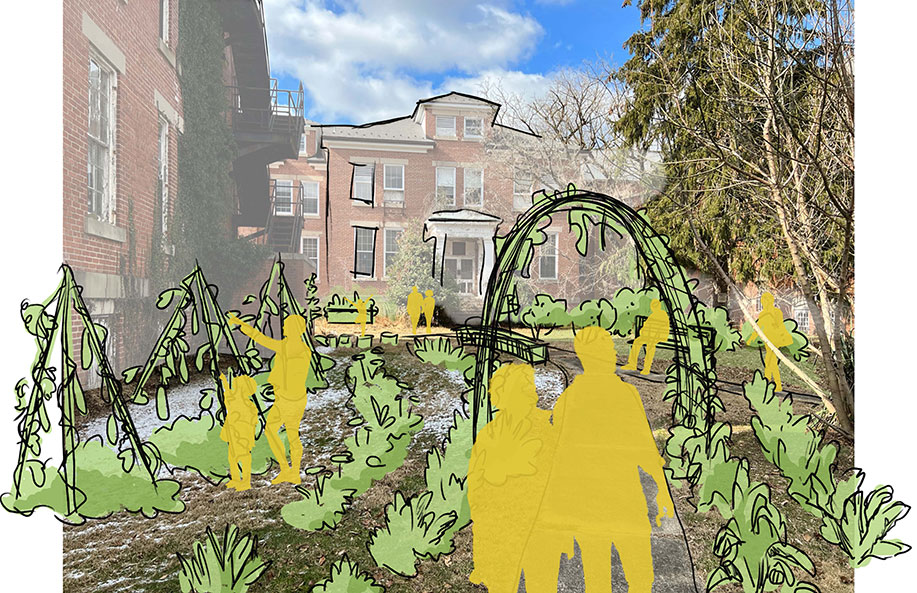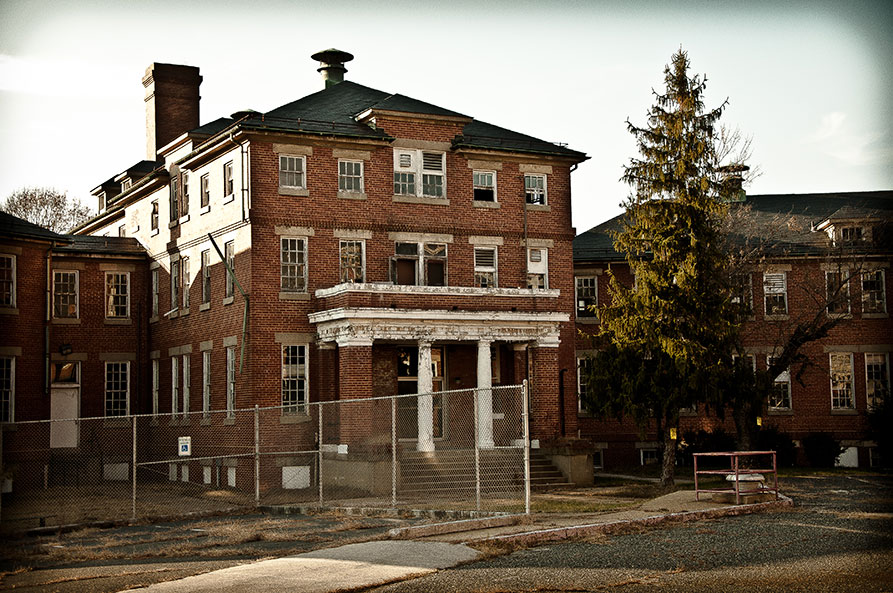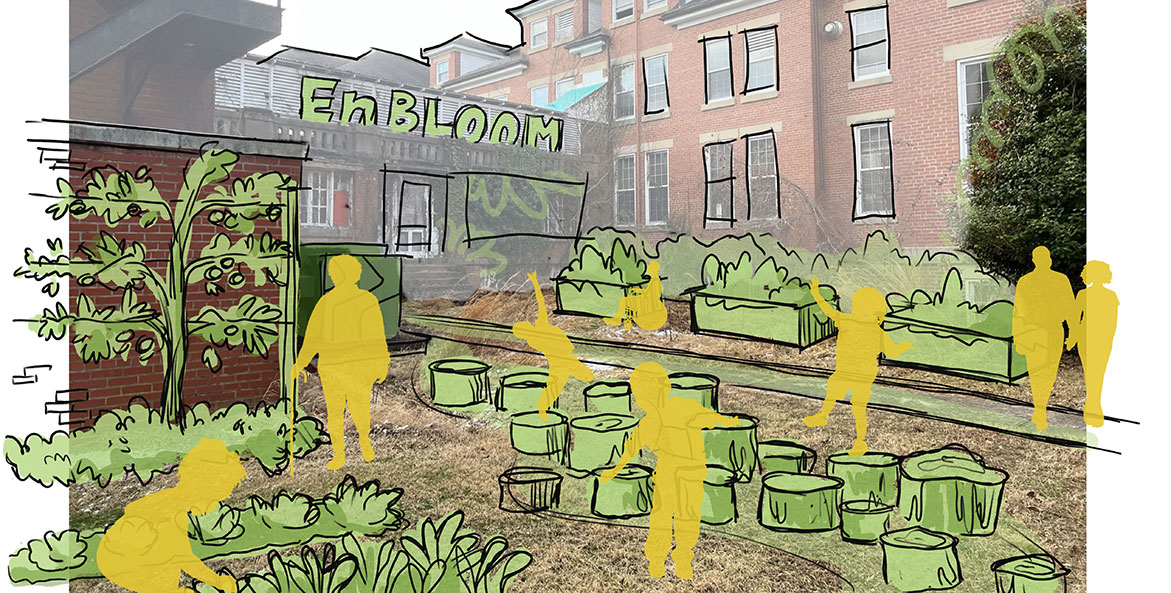As you drive through Crownsville, Maryland, travelers will likely come across several decaying Georgian buildings with little context beyond a sign stating they are part of the Crownsville State Hospital. Vacant since 2004, the site figures in a dark part of Maryland’s history. Originally opened as a mental hospital for the Black community, Crownsville became, by many accounts, a house of horrors that experimented on and abused patients. But a brighter future awaits now that the state has handed over the 544-acre property to Anne Arundel County.
While the next steps will take time, ideas are already circulated as to how best to use the site while honoring its history and the memory of those buried there. I recently spoke with Joi Howard, founding member of enBloom, about her proposal to transform part of the Crownsville site with nature and healing as the centerpiece.
What drew you to the Crownsville site?
I moved to the area in 2015 and happened to pass the Crownsville Hospital Site one day in 2018. I felt drawn to the property in a way that I can’t explain. Around this time, I was going through a rough period mentally, emotionally, and spiritually I started digging into the site’s history, even discovering that I had a family member who ended up at Crownsville. The history of the hospital and its patients, and ultimately the abandonment of the site, resonated with me in a way I wasn’t prepared for.
In my digging, I came across Janice Hayes-Williams who has been vocal about the history of the site and hosts an annual “Say My Name” event that commemorates those who died at Crownsville. Eventually, I met with Williams and we discussed my interest in the property. She was immediately supportive of my interest in the site and invited me to attend her event.
I was, and continue to be, drawn to the site.
How did enBloom come to be?
I had been exploring more holistic practices as well as how food and sustainability are tied to wellbeing. A few friends and I developed a vision for a sustainable, educational garden where people could learn about how nature, food, and wellness are intertwined. We wanted it to be an opportunity for the Black community to feel welcome in the world of agriculture and holistic healing.
The Crownsville State Hospital site provides a perfect opportunity for a project like this. The buildings were built by the patients, they grew their food on the property—it was designed to be a sustainable site. By situating enBloom at Crownsville, we would be reclaiming the narrative of the site. The history of it and the terrible things that happened there—experimentation, abuse, neglect—can never be erased, but a brighter future can literally grow out of that darkness.

EnBloom would transform the historic Crownsville State Hospital into a site of healing and community.
EnviroCollab, LLC
What are the goals of the enBloom project at the Crownsville site?
The possibilities are endless, but our main goals are to create a space that focuses on five elements:
- Climate-Smart Agriculture. We want visitors to enjoy fresh, farm to fork eateries that will be supplied by an onsite working farm and experience firsthand the vitality that regenerative agriculture contributes to a holistically healthy community.
- A Healing Green Space. Nature heals, plain and simple. Therapy and other healing treatments are cost-prohibitive for many even with medical insurance. The former hospital grounds are an ideal location to offer affordable, holistic wellness interventions to connect people with their inner strength and learn healthy techniques to manage life’s challenges.
- Outdoor Learning. We want to provide a space for people of all ages to acquire practical, sustainable living skills from climate-smart growing practices to valuable job training in innovative, green industries. We will also create a space for experiential education (e.g. camps, homeschool enrichment, school field trips) where students can gain valuable skills for immediate use in their daily lives.
- Resource Generation. We are defining a mechanism to distribute wealth building, educational tools, and modalities equitably.
- A Market and Service Hub. Local, environmentally responsible businesses and artisans will have a place to share their wellness products and services with visitors seeking an alternative to more traditional capitalist options.
How can other organizations get involved?
EnBloom is the vision of a small team and will require the work and knowledge of so many to make it a reality. Rob Schnabel, the Maryland restoration specialist at the Chesapeake Bay Foundation, has been the ultimate cheerleader, advising on the current political climate of the county and offering to assist on incorporating regenerative agriculture practices into our work.
Established organizations can help by providing letters of support and partnership as we apply for grant funding and help in getting the word out to the community about our current and future initiatives through blogs/articles, such as this. These same organizations can welcome community-led groups like enBloom to spaces where decisions are being made around Black health and wellness to hear our voices and ideas.
Most importantly, we need land. In 1910, Black farmers owned more than 16 million acres of land; in 2017, that number is just 4.7 million acres—roughly 0.5 percent of all farmland in the country. Healing and wellness powered by climate smart agriculture is challenging enough but without land to grow food and engage the community in environmental connection and stewardship the task is bleak.
Crownsville State Hospital has been vacant for nearly 20 years. Why is it important that this is happening now?
Current events are certainly part of it. Our country is reckoning with a pandemic, racial injustice, and complicated history. Being able to convert a site with a terrible history—one that is ripe for change—into something beautiful and healing is perfect given the current conversations in our country.

Vacant since 2004, Crownsville State Hospital is looking towards a brighter future in the hands of Anne Arundel County.
Stuart McAlpine/Creative Commons
Looking Forward: Anne Arundel County Executive Steuart Pittman has expressed his excitement for the opportunities the site presents. “I want to see that place as a center for healing, a place where mental health, and, really, all health is promoted and encouraged,” Pittman told WYPR in an October 2021 interview. It would be done “in a way that is fiscally responsible and tears down the buildings that should come down and that preserves some of the beautiful architecture that’s there, some of the historic buildings,” he said.
As the process to define the site’s future continues, we look forward to seeing projects like enBloom that address Crownsville’s history while creating a future that puts nature, healing, and important conversations at the forefront.




